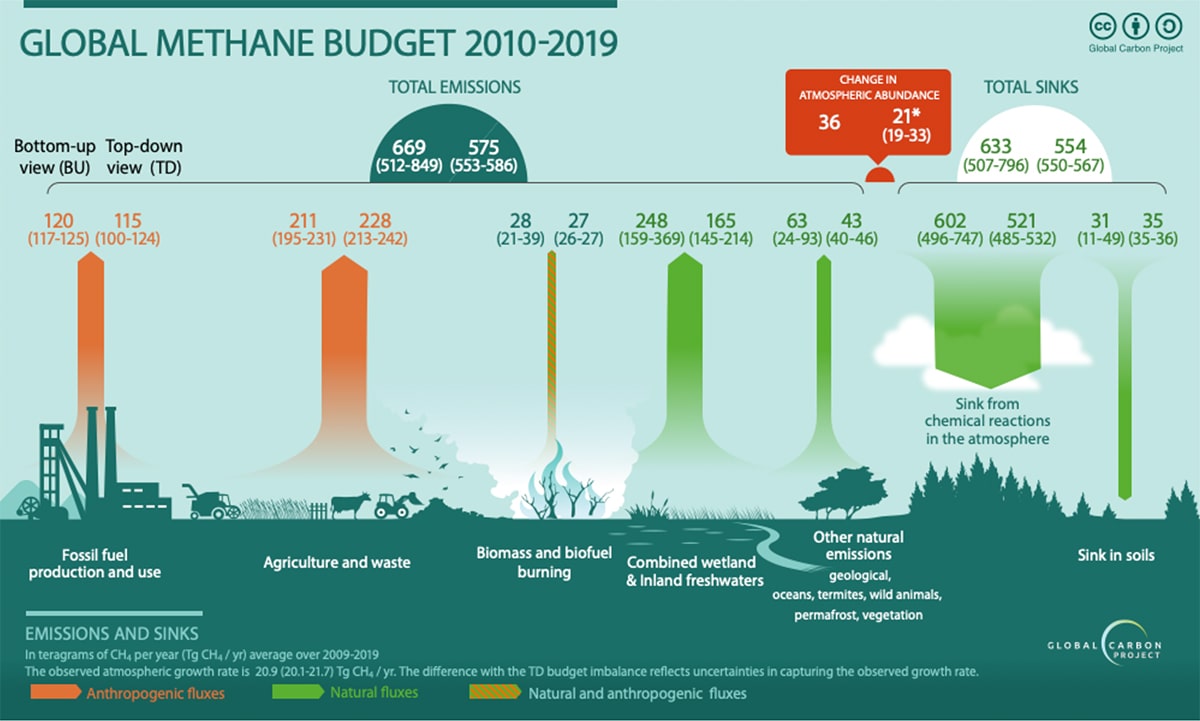4 August 2025

Introduction to the environmental challenge
Atmospheric methane is a powerful greenhouse gas (GHG). Human driven emissions of methane have since the preindustrial era contributed to 0.6oC of global warming, only second to the 0.8oC contributed from emissions of carbon dioxide (CO2) (IPCC, 2023). Methane is emitted from natural and human-driven sources, with anthropogenic emissions accounting for 50-60% of total emissions (Saunois et al., 2025). So, with some behavioural changes, we have a lever to pull to bring down atmospheric levels.
Atmospheric methane is destroyed by the hydroxyl radical, a molecule that you’ve almost certainly not heard about. This radical more or less single-handedly determines the oxidizing capacity of the atmosphere. It is responsible for consuming lots of pollutants, including methane, that would otherwise build up to toxic levels in the atmosphere.
The resulting e-folding lifetime of methane is about 10 years. That means that after 10 years, the initial amount of methane in the atmosphere is reduced by a factor of e – so that about 37% of the original amount remains. This lifetime is short compared to atmospheric CO2, removed by plants, geology, and the ocean, which has an e-folding lifetime nearer 200 years. Action on reducing methane emissions will therefore bear fruit on political timescales and not centuries.

In recognition of that opportunity, the Global Methane Pledge, spearheaded by the US and the European Union (EU), was introduced at COP26 in Glasgow, 2021. It describes a collective goal of reducing global methane emissions by at least 30% from 2020 levels by 2030, with a focus on reducing the contribution from large anthropogenic emission sources.
As of January 2025, 160 countries have signed up to this pledge. Notable absences include China, Russia, and India, and for the time being it is unlikely the US pledge will be actively pursued. Different countries have adopted various strategies to meet their pledged emission reductions, but many have focused on reducing emissions from the fossil fuel production sector.
Arguably, the EU has taken the biggest steps towards meeting their pledge by introducing new regulations to reduce methane emissions from the energy sector, including oil, natural gas, and coal facilities. For brevity, we will discuss oil and gas facilities. Upstream and downstream oil and gas sectors represent about 56% of the fossil fuel emissions of methane and about 20% of total human-driven emissions of methane (Friedlingstein et al., 2025). Based on data from the US (Duren et al., 2019) and Europe (our own calculations), there is a ‘heavy-tailed’ distribution of emissions such that halting emissions from the highest 20% of emitters would result in an 80% reduction in total emissions from natural gas production and use.
EU regulation EU/2024/1787 came into force on 4 August 2024. It requires that all EU operators of oil and gas facilities improve the measurement, reporting, and verification of emissions of methane. As of 5 May 2025, operators are also expected to submit a leak detection and repair programme – with all leaks repaired within two weeks and subsequently monitored to ensure the repair is successful. These include active, inactive, plugged, and abandoned wells. Operators are also banned from routine venting and flaring, an activity driven by economic reasons, e.g. low gas prices. Venting releases methane directly into the atmosphere and, as shown on Flaring Monitor, flaring is the controlled burning of natural gas that converts most of the released methane into CO2.
Using data-driven carbon emission estimates to enforce regulations
What is particularly interesting about EU/2024/1787 is the detail in which the regulation (Article 2) describes fixed and mobile sensor technology needed to measure and verify emissions of methane. The mobile sensors include drones, aircraft, boats, and satellites. Not only that, in Article 31 of the regulation they stipulate that by 5 August 2026 the European Commission will establish a publicly available tool to monitor methane emissions across the globe based on satellite data, with input from “certified data providers and services.”
Empowering regulators with a wider array of data sources, spanning different spatial and sensitivity scales, can only lead to more robust and effective enforcement.
But where does that leave us? Are we as a community ready to deliver that tool? Can we support the data veracity required to be used as evidence in a regulatory framework? How do we combine all these sources to provide one clear, irrefutable picture?
Space-based detection of facility-scale methane leaks
Satellite sensors have for decades monitored atmospheric methane and other gases, but their coarse spatial resolution is limited to quantifying emissions on regional scales.
The recent advent of commercial satellite instruments that observe atmospheric methane with the precision and spatial resolution necessary to to pinpoint emissions at the facility scale, is a game-changer. While global mapping at 50m resolution is not currently feasible, partly due to data volume, a clever partnership has emerged: lower-resolution ‘mappers’ identify broad areas of concern, which then cue precise ‘taskers’ to quantify leaks from known oil and gas infrastructure.
Currently, three dedicated commercial missions operate at the facility scale, with ten more slated for launch in the coming years. Initiatives like the UNEP International Methane Emissions Observatory (IMEO) are actively collecting and collating this invaluable data, paving the way for more effective emissions control.
UNEP International Methane Emissions Observatory (IMEO)
Ensuring no one marks their own homework
Engagement from the Oil and Gas Climate Initiative (OGCI), a consortium of major oil and gas companies, and the UN-backed Oil and Gas Methane Partnership (OGMP) are essential to driving down emissions from the fossil fuel sectors. Confidence in these welcome initiatives relies on the data being open and transparent.
Oil and Gas Climate Initiative (OGCI)
Oil and Gas Methane Partnership (OGMP)
OGCI, through its “Aiming for Zero Methane Emissions Initiative” and methane intensity targets, pushes its members towards near-zero methane emissions by 2030 and invests in mitigation technologies. This includes investment in data collection by the privately-funded Canadian GHGSat instruments:
OGCI, Satellite Monitoring Campaign
OCGI, Results of OGCI Satellite Monitoring Campaign 2022-2023 over Kazakhstan, Algeria and Egypt
Currently, its transparency primarily revolves around reporting aggregate progress and sharing best practices, rather than granular, facility-level data from individual members.
Complementing this, OGMP 2.0 provides the crucial “Gold Standard” measurement-based reporting framework, compelling companies to move beyond estimates to precise, verifiable methane emissions data across their value chains. This transparency, integrated with initiatives like the IMEO, empowers stakeholders to track performance and facilitates effective, data-driven methane reduction strategies across the global oil and gas sector.
A recognised need for measurement standards
The burgeoning volume of data from diverse public and commercial sensors, employing various techniques and scales, is fostering a robust market. However, this very diversity—with potentially contradictory information from space agencies, academics, and startups—could simultaneously erode confidence, especially when regulatory compliance is the goal. For effective regulation, data must be both admissible and resilient to challenge.
This necessitates a suitable standard to assess data quality and fitness-for-purpose in specific applications. Given the rapid evolution of this field, a static, threshold-based standard would quickly become obsolete. Instead, we require a standard that champions rigour, transparency, and evidenced validation of datasets.
A best practice document can provide this essential framework, detailing how to rigorously derive emissions data, key considerations, and the pitfalls of inadequate methodologies. Such a document is now available under the auspices of The Committee on Earth Observation Satellites, specifically targeting the current commercial drive for facility-scale emissions from the oil and gas sectors.
Where do we go from here?
Reducing methane emissions, especially from oil and gas, waste, and agriculture, is crucial. The rise in natural methane emissions also highlights the urgency of controlling human-caused sources. This requires understanding the complex link between human emissions, natural sources, and climate change.
However, methane is just one piece of the puzzle. We need equally strong systems to monitor, report, and verify all greenhouse gas emissions, including CO2, across every sector, e.g. energy, industry, and land use. To support ambitious climate policies like the Fit for 55 package, the EU requires sophisticated, integrated monitoring, reporting, and verification (Janssens-Maenhout et al., 2020). These systems must provide precise, verifiable data for all greenhouse gases, including methane and CO2 from difficult-to-abate sectors. This means prioritising data quality, transparency, and interoperability across all monitoring platforms, including satellites, to ensure climate targets are met with verifiable progress.
Satellite data are revealing the location and magnitude of methane leaks with such precision that the EU’s crackdown ensures that polluters have nowhere to run or hide. Watch this space for what happens next.
References
Duren, R.M. et al. (2019) California’s methane super-emitters, Nature, 575(7781).
Friedlingstein, P. et al. (2025) Global Carbon Budget 2024, Earth System Science Data, 17(3), pp. 965–1039.
IPCC (2023) Climate Change 2021 – The Physical Science Basis: Working Group I Contribution to the Sixth Assessment Report of the Intergovernmental Panel on Climate Change. 1st edn. Cambridge University Press.
Janssens-Maenhout, G. et al. (2020) Toward an Operational Anthropogenic CO2 Emissions Monitoring and Verification Support Capacity, Bulletin of the American Meteorological Society, 101(8), pp. E1439–E1451.
Saunois, M. et al. (2025) Global Methane Budget 2000–2020, Earth System Science Data, 17(5), p

Paul I. Palmer
Professor of Quantitative Earth Observation at the National Centre for Earth Observation, University of Edinburgh

Paul D. Green
Principal Research Scientist at the Earth Observation & Climate Group, National Physical Laboratory